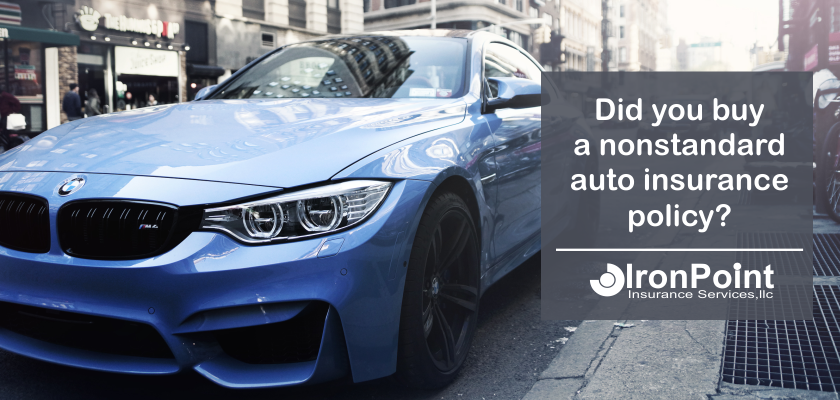Did You Buy a Nonstandard Auto Insurance Policy?

In a recent post we talked a lot about a segment of the auto insurance market called nonstandard auto insurance, and it struck me … many of you may not be familiar with the term nonstandard auto insurance.
Why would you?
When I began my career in insurance, I was a product analyst for a private passenger auto insurance carrier and at the time I didn’t know of nonstandard auto insurance.
I recall a business review meeting I attended very early in my career, and I asked what I thought was a “good” question. I was still getting my “insurance legs,” so I didn’t know any better, so I asked why our company didn’t market or advertise to the consumer.
The president of the company looked at me, and a said, and I’m paraphrasing, “nobody is out there saying I just got to get me some of that nonstandard auto insurance. That’s some real good stuff, and I just can’t wait to get me some.”
That’s when it hit me, I was working for a nonstandard auto insurance carrier … maybe I needed to understand the product I was pricing and helping to manage. Since auto insurance was (and still is) my job, it made sense for me to dig in and learn about the market segment I working within.
Heck, in many ways my job continues to be understanding nonstandard auto insurance products and policy language.
As a consumer it’s not your job, however, to know the nuances to auto insurance product and market segmentation, you rely on professionals, like insurance agents, to explain to you the types of insurance products you buy.
Too frequently blogs that advocate ways to spend insurance dollars, and even some insurance agents, don’t inform the consumer about the nuances of the nonstandard auto market – or even the standard or preferred markets for that matter. This leads consumers to make poor decisions and get bad results from their insurance protection.
Nonstandard auto insurance is not a bad thing
In years past there were fewer auto insurance options, and insurance companies lacked the pricing sophistication to create a rate for “all” risks. This led insurance companies to make choices who they would and would not insure.
Today, with the advancements in multivariate pricing techniques, auto insurance carriers can create a price for just about any risk. This means most insurance carriers have a broader appetite and can underwrite nearly all of the shoppers in the market.
While this is good for the insurance carrier and the long term stability of the insurance market, it can create issues for consumers who are classified as higher risk. Since pricing is setup to allocate risk premium in proportion to your probability of loss, it is natural these consumer are going to have to pay more for their auto insurance (all things being equal).
With pressure building up on “higher” risk consumer to pay these premium it opened up a new market opportunity for the most sophisticated “pricers” … the nonstandard auto insurance market was born. To make this really work, it would also require a change in the amount of coverage and service that is offered in the standard and preferred markets.
The industry, in essence, had created a “value” product offering. An auto insurance product that could be sold to price sensitive, higher risk consumers. In practical terms this isn’t any different than any other product category. In nearly all product categories consumers can quickly identify the luxury, premium or value brand or product options.
Nonstandard auto products services a demand in the market. This is a good thing.
What makes this challenging for consumers is that there is no way to immediately tell if you’ve purchased a nonstandard or standard auto insurance product. The only way to really know is for someone to tell you.
Nonstandard auto insurance is not a bad thing, there are very good companies who provide this type of coverage, but if you purchase a nonstandard auto insurance policy without understanding the differences, you’re subject to getting disappointed during a claim experience.
Do you have a nonstandard auto insurance policy?
If you are unsure, you should ask your insurance agent or the person selling you the auto insurance if you’re buying a nonstandard auto insurance policy. If they tell you yes, then you should ask what coverage limitations does the policy have compared to a standard or preferred auto insurance policy.
If you are satisfied with those limitations, then you are making an informed purchase and you can avoid those behaviors that aren’t covered by the policy.
To be completely informed you also need to ask about the service, claims and billing practices if you’re going to purchase nonstandard auto insurance. In order to provide a competitive auto insurance rate, these companies typically reduce coverage, provide lower service levels, have strict billing rules (as it pertains to cancellation for nonpayment), and typically have fewer insurance adjusters.
Another thing you want to inquire about are the fees charged. Some carriers will quote the premiums and policy fee, but surprise you with high transaction or billing fees. Make sure you fully understand the total cost of ownership before you buy.
Am I a nonstandard auto insurance risk?
This isn’t really an easy questions to answer. The definition of nonstandard auto insurance is slightly different from company-to-company. However, it is generally understood that following risk characteristics are classically nonstandard:
- A history of only buying minimum financial responsibility limits
- Having more than one violation or accident in the past 3-years
- Having lapses or reinstatement of your auto insurance in the past 3-years
It’s really this simple. If you have one of these then you’ll likely find your premiums in the standard and preferred insurance market are a bit higher (but you’ll get the better coverage and service). If you have all three than you’re most likely nonstandard. 🙂
If you’re going to purchase nonstandard auto insurance, then ask the questions above and make sure you’re getting the best nonstandard auto insurance carrier available.
Conclusion
As was said earlier, not all nonstandard insurance carriers are bad. But the “bad” reputation the insurance industry has mostly likely gets its roots in the actions of these types of carriers. They do provide less coverage.
If consumers aren’t aware that they have purchased a nonstandard auto insurance policy, they can be disappointed during a claims experience. However, as long as you are aware of what you’re buying, if you can understand a policy’s limitations so you can avoid the risks that aren’t covered, management you payment habits to conform, then these types of value insurance policies can be beneficial to consumers who have more need to manage the monthly budget than to protect assets.
But if you have the need to protect assets, and need coverage, you should be purchasing your home, business or auto insurance with a standard or preferred insurance carrier.
Image Source: Zan Ilic

Compare Quotes Online
Want to know if you can save on home or auto insurance? See for yourself. Start a quote today.
Give us a Ring
1-877-334-7646
Call today and speak with a professional insurance agent.